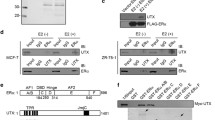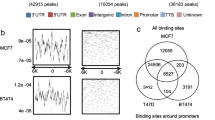Abstract
The zinc finger E-box binding transcription factor ZEB1 (δEF1/Nil-2-a/AREB6/zfhx1a/TCF8/zfhep/BZP) is emerging as an important regulator of the epithelial to mesenchymal transitions (EMT) required for development and cancer metastasis. ZEB1 promotes EMT by repressing genes contributing to the epithelial phenotype while activating those associated with the mesenchymal phenotype. TCF8 (zfhx1a), the gene encoding ZEB1, is induced by several potentially oncogenic ligands including TGF-β, estrogen, and progesterone. TGF-β appears to activate EMT, at least in part, by inducing ZEB1. However, our understanding of how ZEB1 contributes to signaling pathways elicited by estrogen and progesterone is quite limited, as is our understanding of its functional roles in normal adult tissues. To begin to address these questions, a human tissue mRNA array analysis was done. In adults, the highest ZEB1 mRNA expression is in bladder and uterus, whereas in the fetus highest expression is in lung, thymus, and heart. To further investigate the regulation of TCF8 by estrogen, ZEB1 mRNA was measured in ten estrogen-responsive cell lines, but it is only induced in the OV266 ovarian carcinoma line. Although high expression of ZEB1 mRNA is estrogen-dependent in normal human ovarian and endometrial biopsies, high expression is estrogen-independent in late stage ovarian and endometrial carcinomas, raising the possibility that deregulated expression promotes cancer progression. In contrast, TCF8 is at least partially deleted in 4 of 5 well-differentiated, grade I endometrial carcinomas, which may contribute to their non-aggressive phenotype. These data support the contention that high ZEB1 encourages gynecologic carcinoma progression.






Similar content being viewed by others
References
Aigner K, Dampier B, Descovich L et al (2007) The transcription factor ZEB1 (δEF1) promotes tumour cell dedifferentiation by repressing master regulators of epithelial polarity. Oncogene 26:6979–6988. doi:10.1038/sj.onc.1210508
Eger A, Aigner K, Sonderegger S et al (2005) DeltaEF1 is a transcriptional repressor of E-cadherin and regulates epithelial plasticity in breast cancer cells. Oncogene 24:2375–2385. doi:10.1038/sj.onc.1208429
Guaita S, Puig I, Franci C et al (2002) Snail induction of epithelial to mesenchymal transition in tumor cells is accompanied by MUC1 expression and ZEB1 expression. J Biol Chem 277:39209–39216. doi:10.1074/jbc.M206400200
Chua HL, Bhat-Nakshari P, Clare SE et al (2007) NF-kB represses E-cadherin expression and enhances epithelial to mesenchymal transition of mammary epithelial cells: potential involvement of ZEB-1 and ZEB-2. Oncogene 26:711–724. doi:10.1038/sj.onc.1209808
Liu Y, El-Naggar S, Darling DS et al (2008) Zeb1 links epithelial-mesenchymal transition and cellular senescence. Development 135:579–588. doi:10.1242/dev.007047
Spaderna S, Schmalhofer O, Wahlbuhl M et al (2008) The transcriptional repressor ZEB1 promotes metastasis and loss of cell polarity in cancer. Cancer Res 68:537–544. doi:10.1158/0008-5472.CAN-07-5682
Peinado H, Olmeda D, Cano A (2007) Snail, ZEB and bHLH factors in tumour progression: an alliance against the epithelial phenotype. Nat Rev Cancer 7:415–428. doi:10.1038/nrc2131
Shirakihara T, Saitoh M, Miyazono K (2007) Differential regulation of epithelial and mesenchymal markers by δEF1 proteins in epithelial-mesenchymal transition induced by TGF-β. Mol Biol Cell 18:3533–3544. doi:10.1091/mbc.E07-03-0249
Dohadwala M, Yang S-C, Luo J et al (2006) Cyclooxygenase-2-dependent regulation of E-cadherin: prostaglandin E2 induces transcriptional repressors ZEB1 and Snail in non-small cell lung cancer. Cancer Res 66:5338–5345. doi:10.1158/0008-5472.CAN-05-3635
Kirschmann DA, Seftor EA, Nieva DRC et al (1999) Differentially expressed genes associated with the metastatic phenotype in breast cancer. Breast Cancer Res Treat 55:127–136. doi:10.1023/A:1006188129423
Pena C, Garcia JM, Silva J et al (2005) E-cadherin and vitamin D receptor regulation by SNAIL and ZEB1 in colon cancer: clinicopathological correlations. Hum Mol Genet 14:3361–3370. doi:10.1093/hmg/ddi366
Spoelstra NS, Manning NG, Higashi Y et al (2006) The transcription factor ZEB1 is aberrantly expressed in aggressive uterine cancers. Cancer Res 66:3893–3902. doi:10.1158/0008-5472.CAN-05-2881
Krafchak CM, Pawar H, Moroi SE (2005) Mutations in TCF8 cause posterior polymorphous corneal dystrophy and ectopic expression of COL4A3 by corneal endothelial cells. Am J Hum Genet 77:694–708. doi:10.1086/497348
Liskova P, Tuft SJ, Gwilliam R et al (2007) Novel mutations in the ZEB1 gene identified in Czech and British patients with posterior polymorphous corneal dystrophy. Hum Mutat 28:638–643. doi:10.1002/humu.9495
Chamberlain EM, Sanders MM (1999) Identification of the novel player δEF1 in estrogen transcriptional cascades. Mol Cell Biol 19:3600–3606
Richer JK, Jacobsen BM, Manning NG et al (2002) Differential gene regulation by the two progesterone receptor isoforms in human breast cancer cells. J Biol Chem 277:5209–5218. doi:10.1074/jbc.M110090200
Locklin RM, Riggs BL, Hicok KC et al (2001) Assessment of gene regulation by bone morphogenetic protein 2 in human marrow stromal cells using array technology. J Bone Miner Res 16:2192–2204. doi:10.1359/jbmr.2001.16.12.2192
Manavella PA, Roqueiro G, Darling DS et al (2007) The ZFHX1A gene is differentially autoregulated by its isoforms. Biochem Biophys Res Commun 360:621–626. doi:10.1016/j.bbrc.2007.06.088
Liu Y, Costantino ME, Montoya-Durango D et al (2007) The zinc finger transcription factor ZFHX1A is linked to cell proliferation by Rb-E2F1. Biochem J 408:79–85. doi:10.1042/BJ20070344
Funahashi J-I, Sekido R, Murai K (1993) δ-crystallin enhancer binding protein δ-EF1 is a zinc finger-homeodomain protein implicated in postgastrulation embryogenesis. Development 119:433–446
Conover CA, Hartmann LC, Bradley S et al (1998) Biological characterization of human epithelial ovarian carcinoma cells in primary culture: the insulin-like growth factor system. Exp Cell Res 238:439–449. doi:10.1006/excr.1997.3861
Mo B, Vendrov AE, Palomino WA et al (2006) ECC-1 cells: a well-differentiated steroid-responsive endometrial cell line with characteristics of luminal epithelium. Biol Reprod 75:387–394. doi:10.1095/biolreprod.106.051870
Baldwin W, Curtis S, Cauthen C et al (1998) BG-1 ovarian cell line: an alternative model for examining estrogen-dependent growth in vitro. In Vitro Cell Dev Biol 34:649–654
Carney SA, Tahara H, Swartz CD et al (2002) Immortalization of human uterine leiomyoma and myometrial cell lines after induction of telomerase activity: molecular and phenotypic characteristics. Lab Invest 82:719–728. doi:10.1097/01.LAB.0000017499.51216.3E
Palmer-Densmore M, Deachapunya C, Kannan M et al (2002) UTP-dependent inhibition of Na + absorption requires activation of PKC in endometrial epithelial cells. J Gen Physiol 120:897–906. doi:10.1085/jgp. 20028608
Abal M, Planaguma J, Gil-Moreno A et al (2006) Molecular pathology of endometrial carcinoma: transcriptional signature in endometrioid tumors. Histol Histopathol 21:197–204
van Grunsven LA, Taelman V, Michiels C et al (2006) δEF1 and SIP1 are differentially expressed and have overlapping activities during Xenopus embryogenesis. Dev Dyn 235:1491–1500. doi:10.1002/dvdy.20727
Miyoshi T, Van De Putte T, Kondoh H (2006) Complementary expression pattern of zfhx1 genes Sip1 and δEF1 in the mouse embryo and their genetic interaction revealed by compound mutants. Dev Dyn 235:1941–1952. doi:10.1002/dvdy.20799
Takagi T, Moribe H, Kondoh H (1998) δEF1, a zinc finger and homeodomain transcription factor, is required for skeleton patterning in multiple lineages. Development 125:21–31
Witta SE, Gemmill RM, Hirsch FR et al (2006) Restoring E-cadherin expression increases sensitivity to epidermal growth factor receptor inhibitors in lung cancer cell lines. Cancer Res 66:944–950. doi:10.1158/0008-5472.CAN-05-1988
Wang J, Scully K, Zhu X et al (2007) Opposing LSD1 complexes function in developmental gene activation and repression programs. Nature 446:882–887. doi:10.1038/nature05671
Hall JM, Korach KS (2003) Stromal cell-derived factor 1, a novel target of estrogen receptor action, mediates the mitogenic effects of estradiol in ovarian and breast cancer cells. Mol Endocrinol 17:792–803. doi:10.1210/me.2002-0438
Piatak M, Luk KC, Williams B et al (1993) Quantitative competitive polymerase chain reaction for accurate quantitation of HIV DNA and RNA species. Biotechniques 14:70–81
Willey JC, Crawford EL, Jackson CM et al (1998) Expression measurement of many genes simultaneously by quantitative RT-PCR using standardized mixtures of competitive templates. Am J Respir Cell Mol Biol 19:6–17
Souaze F, Ntodou-Thome A, Tran CY et al (1996) Quantitative RT-PCR: limits and accuracy. Biotechniques 21:280–285
Shang Y (2006) Molecular mechanisms of oestrogen and SERMs in endometrial carcinogenesis. Nat Rev Cancer 6:360–368. doi:10.1038/nrc1879
Riman T, Nilsson S, Persson IR (2004) Review of epidemiological evidence for reproductive and hormonal factors in relation to the risk of epithelial ovarian malignancies. Acta Obstet Gynecol Scand 83:783–795. doi:10.1111/j.0001-6349.2004.00550.x
Cappellen D, Diez Gil, de Medina S, Chopin D et al (1997) Frequent loss of heterozygosity on chromosome 10q in muscle-invasive transitional cell carcinomas of the bladder. Oncogene 14:3059–3066. doi:10.1038/sj.onc.1201154
Lax SF (2007) Molecular genetic changes in epithelial, stromal and mixed neoplasms of the endometrium. Pathology (Phila) 39:46–54
Mutter GL, Baak JPA, Fitzgerald JT (2001) Global expression changes of constitutive and hormonally regulated genes during endometrial neoplastic transformation. Gynecol Oncol 83:177–185. doi:10.1006/gyno.2001.6352
Williams TW, Moolten D, Burlein J et al (1991) Identification of a zinc finger protein that inhibits IL-2 gene expression. Science 254:1791–1794. doi:10.1126/science.1840704
Grooteclaes ML, Frisch SM (2000) Evidence for a function of CtBP in epithelial gene regulation and anoikis. Oncogene 19:3823–3828. doi:10.1038/sj.onc.1203721
Spaderna S, Schmalhofer O, Hlubek F et al (2006) A transient, EMT-linked loss of basement membranes indicates metastasis and poor survival in colorectal cancer. Gastroenterology 131:830–840. doi:10.1053/j.gastro.2006.06.016
Fontemaggi G, Gurtner A, Strano S et al (2001) The transcriptional repressor ZEB regulates p73 expression at the crossroad between proliferation and differentiation. Mol Cell Biol 21:8461–8470. doi:10.1128/MCB.21.24.8461-8470.2001
Fontemaggi G, Gurtner A, Damalas A et al (2005) DeltaEF1 repressor controls selectively p53 members during differentiation. Oncogene 24:7273–7280. doi:10.1038/sj.onc.1208891
Watanabe Y, Kawakami K, Hirayama Y et al (1993) Transcription factors positively and negatively regulating the Na, K-ATPase α1 subunit gene. J Biochem 114:849–855
Furusawa T, Moribe H, Kondoh H et al (1999) Identification of CtBP1 and CtBP2 as corepressors of zinc finger-homeodomain factor δEF1. Mol Cell Biol 19:8581–8590
Darling DS, Gaur NK, Zhu B (1998) A zinc finger homeodomain transcription factor binds specific thyroid hormone response elements. Mol Cell Endocrinol 139:25–35. doi:10.1016/S0303-7207(98)00076-8
Nishimura G, Manabe I, Tsushima K et al (2006) δEF1 mediates TCF-β signaling in vascular smooth muscle cell differentiation. Dev Cell 11:93–104. doi:10.1016/j.devcel.2006.05.011
Qazi HAR, Goyal S, Mellon JK et al (2008) ZEB1 function in bladder cancer. J Urol 179:757. doi:10.1016/S0022-5347(08)60765-X
Qazi HAR, Goyal S, Mellon JK et al (2008) The function of ZEB1 in bladder cancer. J Urol 179:879. doi:10.1016/S0022-5347(08)60765-X
Postigo AA, Dean DC (1999) Independent repressor domains in ZEB regulate muscle and T-cell differentiation. Mol Cell Biol 19:7961–7971
Postigo AA, Sheppard AM, Mucenski ML et al (1997) c-Myb and Ets proteins synergize to overcome transcriptional repression by ZEB. EMBO J 16:3924–3934. doi:10.1093/emboj/16.13.3924
Tashiro H, Blazes MS, Wu R et al (1997) Mutations in PTEN are frequent in endometrial carcinoma but rare in other common gynecological malignancies. Cancer Res 57:3935–3940
Persson I (2000) Estrogens in the causation of breast, endometrial and ovarian cancers-evidence and hypotheses from epidemiological findings. J Steroid Biochem Mol Biol 74:357–364. doi:10.1016/S0960-0760(00)00113-8
Acknowledgments
This research was supported by NIH grants R01 DK40082 and DK061913 to MMS. The technical assistance of Michelle Hon is gratefully acknowledged.
Author information
Authors and Affiliations
Corresponding author
Rights and permissions
About this article
Cite this article
Hurt, E.M., Saykally, J.N., Anose, B.M. et al. Expression of the ZEB1 (δEF1) transcription factor in human: additional insights. Mol Cell Biochem 318, 89–99 (2008). https://doi.org/10.1007/s11010-008-9860-z
Received:
Accepted:
Published:
Issue Date:
DOI: https://doi.org/10.1007/s11010-008-9860-z




